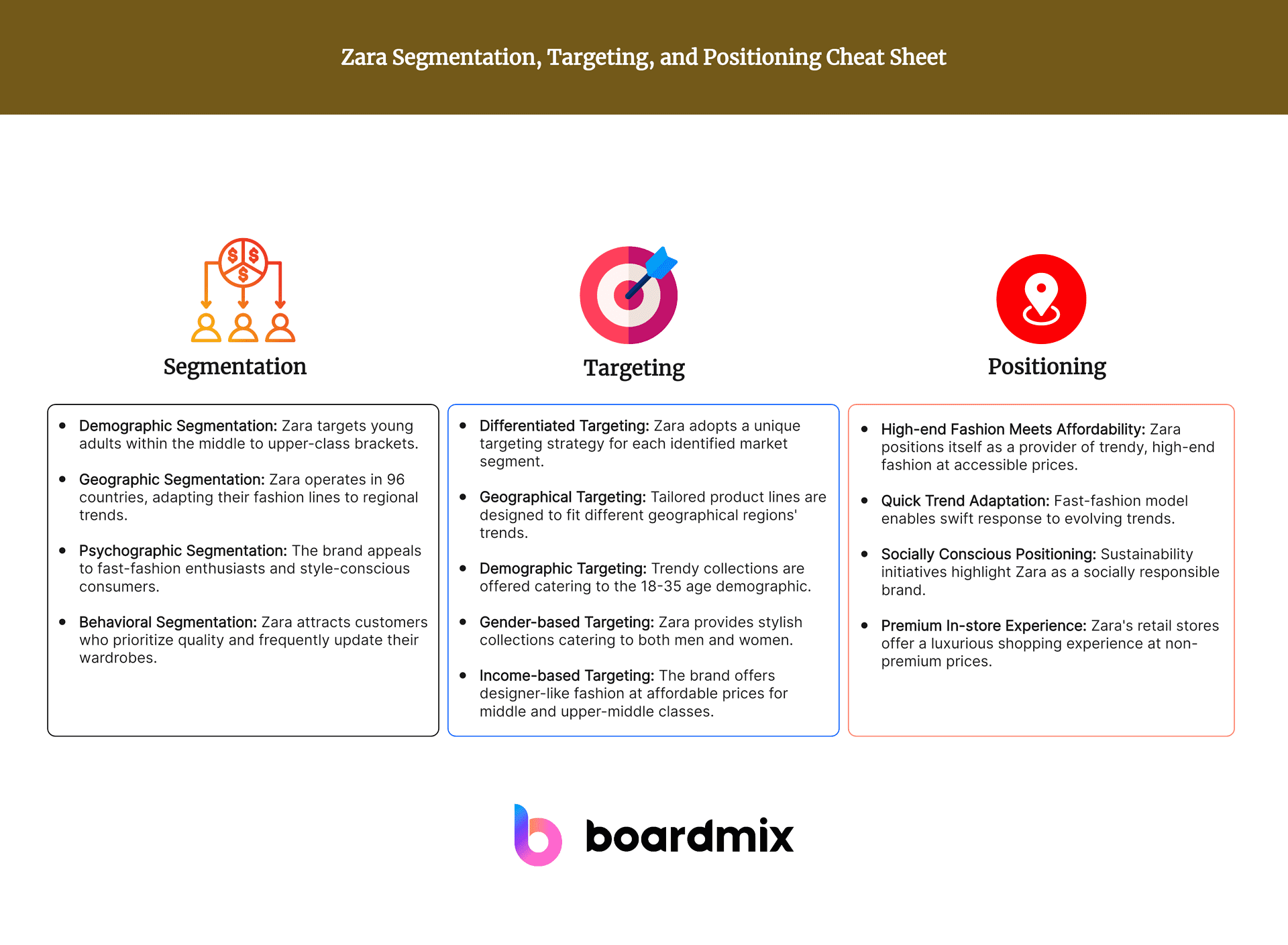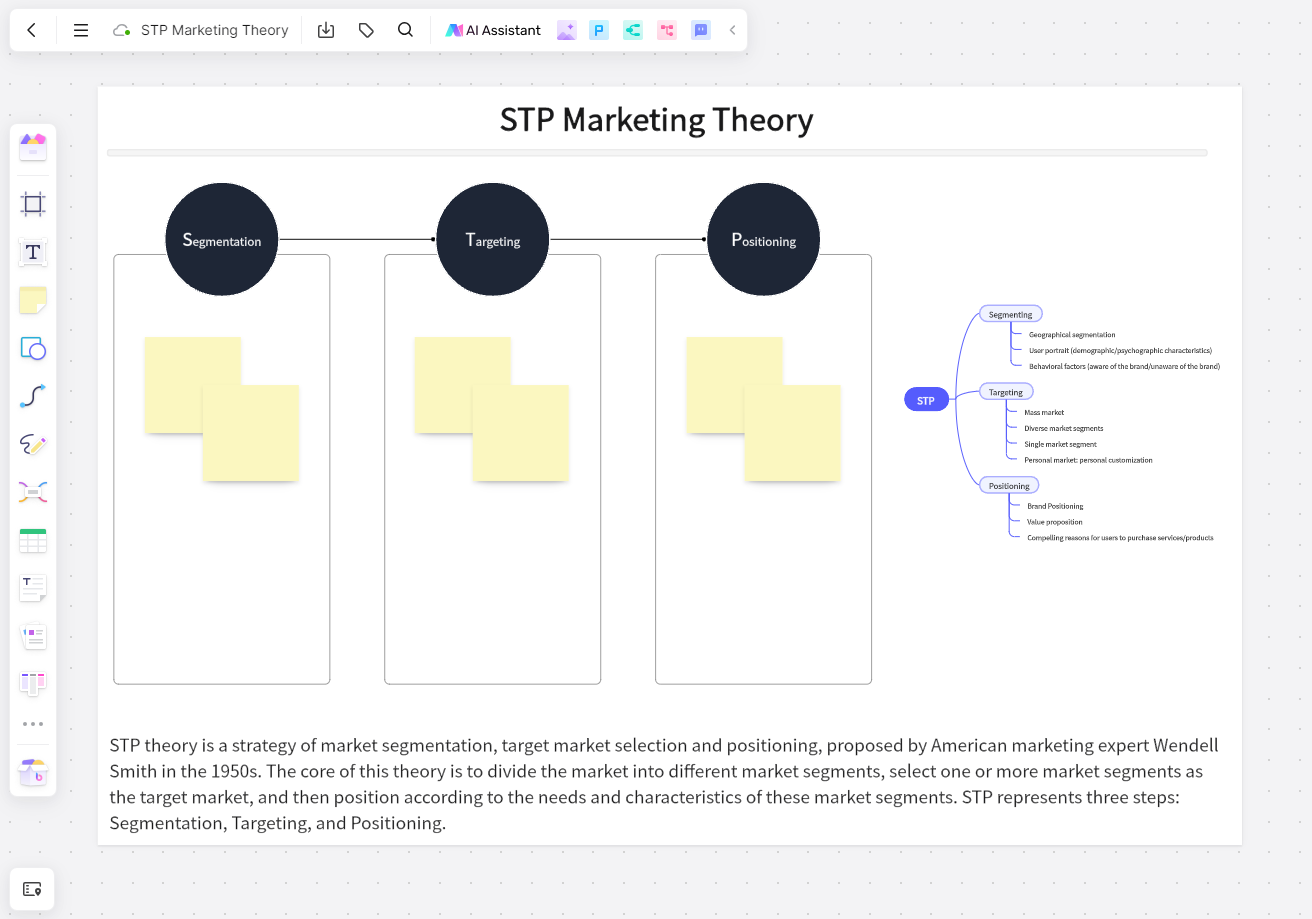In the dynamic and ever-evolving world of fashion, one name that stands out prominently is Zara. Renowned for its fast-fashion concept, this Spanish behemoth has carved a niche for itself in the industry. What has underpinned Zara's tremendous success is its effective segmentation, targeting, and positioning (STP) strategy. This article will provide an exhaustive analysis of Zara’s STP approach and elucidate how it underlines the brand's global dominance.
Zara Segmentation, Targeting, and Positioning Mind Map
A visual representation of Zara's STP strategy can be best captured through a mind map. This illustrative tool breaks down complex concepts into manageable elements, rendering them easier to grasp. Our Zara STP mind map will be included here, highlighting the vital aspects of their strategy, thus offering an excellent graphical overview.

Market Segmentation of Zara
In the competitive fashion landscape, a precise and well-articulated market segmentation strategy is vital for standing out, a task that Zara executes with finesse. Zara's approach to market segmentation relies on a blend of demographic, geographic, psychographic, and behavioral factors. By analyzing each of these facets in detail, we gain insight into Zara's dominance in the global market.
Firstly, in demographic segmentation, age and income stand as paramount factors. Zara primarily caters to the younger generation, specifically individuals aged 18 to 35 years. This age group is known for its fashion-forward thinking and willingness to spend on clothing. Catering to this age bracket, Zara introduces new items frequently, keeping the selection fresh and enticing.
In addition, the income segment targeted by Zara is the middle to upper-class. These consumers desire fashionable clothing reflecting current trends without the steep prices of high-end brands. Zara ingeniously fulfills this demand by offering runway-inspired fashion at accessible prices, bridging the gap between luxury and affordability.
In geographic segmentation, Zara’s operations extend across 96 countries, with particular emphasis on Europe, Asia, and America. This extensive reach caters to diverse cultural fashion preferences, considering regional climate and styles. For instance, Zara's European outlets would house a significant winter collection compared to Asian stores due to varying weather conditions.
On the psychographic front, Zara targets consumers who prioritize fashion trends and appreciate swift style changes. These individuals value looking stylish and staying ahead in fashion, aligning perfectly with Zara's business model of fast fashion.
Finally, in terms of behavioral segmentation, Zara appeals to customers seeking quality and style. The brand capitalizes on consumer behavior where stylish yet affordable options are preferred over expensive designer wear. Additionally, frequent turnover of styles encourages repeated visits by customers, a behavioral trait that Zara leverages effectively.
Targeting of Zara
Post segmentation, the next pillar in Zara's successful marketing strategy is their approach to targeting. They employ a differentiated targeting strategy where each segment identified through their segmentation strategy is targeted uniquely, taking into account the preferences and needs of each group. This attention to detail at every customer touchpoint is what gives Zara its competitive advantage.
One of the salient features of Zara's targeting strategy is the manner in which they target their geographically segmented market. Having established its presence in over 96 countries, Zara comprehends that every region requires a tailor-made approach. For instance, considering the climatic diversity, Zara's winter collection would be far more extensive in European markets compared to warmer regions like Asia and Africa. Thus, they adapt their product offering based on the geographical location to meet the customers' needs effectively.
In terms of demographic targeting, Zara pays keen attention to the specific fashion preferences of its identified age group of its user persona– individuals aged between 18 and 35 years. They consistently offer trendy collections that align with the latest fashion, attracting this fashion-conscious demographic who are keen on keeping up with ever-evolving styles.
Zara's gender-based targeting also merits discussion. They offer stylish and trendy collections for both men and women, ensuring their product range is diverse enough to cater to the unique fashion tastes of both genders. Whether it's chic office wear, comfortable casuals, or occasion-specific attire, Zara ensures their collections meet the diverse needs of their targeted customers.
Lastly, income-based targeting is an area where Zara shines bright. By offering designer-like fashionable clothing at affordable prices, Zara effectively targets the middle and upper-middle-class segment. These consumers desire high-end fashion but are price-conscious, making them the perfect target for Zara's affordable yet stylish clothing lines.
Positioning of Zara
In the world of branding, positioning stands as a crucial strategy that determines how a brand differentiates itself from its competitors and sits in the minds of the consumers. This strategic approach is particularly noteworthy in the fast-paced fashion industry where staying relevant is paramount. Let's delve into Zara's masterstroke of positioning and understand how it helps them maintain an upper hand in the market.
Zara ingeniously positions itself at an intersection where high-end fashion meets affordability. Its USP lies in delivering high-quality, trend-setting clothing and accessories that echo the vibes of luxurious designer labels yet don’t burn a hole in the consumer's pocket. This unique positioning has created a strong brand image that appeals to a wide range of customers, especially the middle to upper-middle-class demographic that craves high-end fashion at affordable prices.
Another aspect that significantly bolsters Zara’s brand positioning is its uncanny knack for quick trend adaptation. The brand's success lies in its fast-fashion model, which allows it to introduce new trends swiftly to the market. Unlike traditional fashion brands that operate based on seasonal collections, Zara drops new designs almost bi-weekly. This rapid turnover ensures that customers always have something new and trendy to look forward to, reinforcing Zara’s image as a trailblazer in the fast-fashion sector.
Zara also positions itself as a socially conscious brand. They have several initiatives focused on sustainability and reducing environmental impact, such as their “Join Life” collection and in-store recycling programs. By demonstrating concern for social issues, Zara appeals to a growing base of environmentally-conscious consumers, strengthening their overall brand positioning.
Additionally, Zara has carefully curated its store experience to further cement its brand identity. Their retail stores often situated in prime locations exude a high-end vibe, showcasing products in a sophisticated and classy ambience. This well-thought-out store experience complements Zara’s position as a brand that offers premium fashion at non-premium prices.
Zara Segmentation, Targeting, and Positioning Cheat Sheet
To facilitate a better understanding of Zara's STP strategy, we'll be including a cheat sheet here. This valuable resource will summarise the key points discussed above into a quick reference guide that you can easily revert to for recollection or analysis.

Key Takeaways: STP Template & Tool
This in-depth analysis underscores Zara's brilliant application of STP strategy. By segmenting the market, effectively targeting those segments, and positioning its products accurately, Zara has managed to gain a competitive advantage and establish a strong brand identity.
To devise a similar robust STP strategy for your brand, consider using Boardmix, our efficient solution. With our pre-built Market Segmentation Template and STP Analysis Template, you can streamline your marketing efforts and make informed decisions for achieving business success.

Boardmix is an instrumental tool designed to tap into your creativity and bring structure to your ideas. With its digital canvas, it empowers users for online collaboration involving seneries like design research, marketing analysis, business plan, daily meeting, weekly plan and online education. It offers one-stop solution of online whiteboard, flowcharts, mind maps, brainstorming, hybrid work, scrum tool and so on. Boardmix also integrated comprehensive AI-generation features like AI Presentation, AI Image, AI Mind Map and so on. BoardMix's online whiteboard combines advanced technology with ease of use, simplifying team brainstorming, data analysis, document drafting, and information visualization.
In essence, Boardmix stands as a multifaceted tool that brings a new dimension to idea generation and thought organization. With its straightforward interface, collaborative features, adaptive templates, smooth integrations, and budget-friendly pricing, Boardmix Mind Mapping certainly merits a try. Experience how it can transform your mind mapping process. Try to make your analysis with Boardmix right now!








